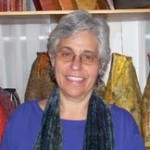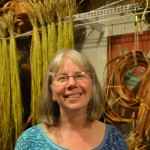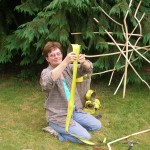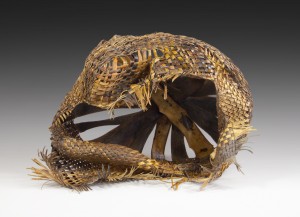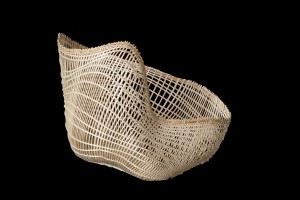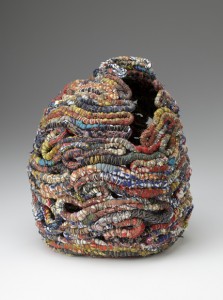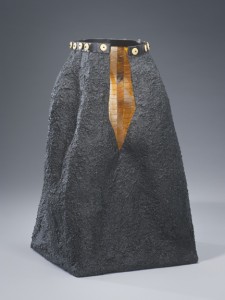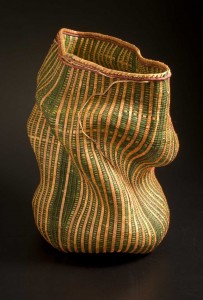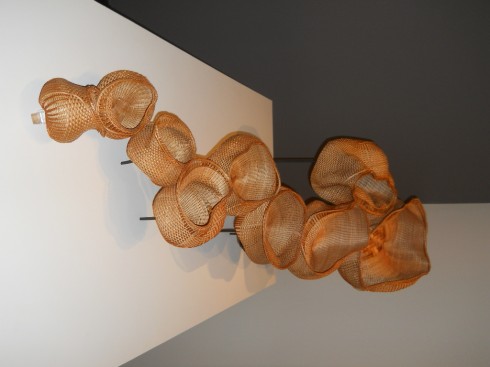Jackie Abrams, an East Coast fiber artist, and artists Judy Zugish and Polly Adams Sutton, both based on the West Coast, are sought-after teachers with national reputations in basketry & sculptural design. Here they reflect on their inspirations & materials, and about teaching design:
Where do you get your inspiration for your sculptural art?
Judy: My best pieces are story pieces. An idea captures my attention and I have no choice but to weave its story. This is where my deep relation to my materials comes in; without them, I wouldn’t know how to tell the story. For instance, in my piece “Fukushima Tsunami”
I was gathering my willow bark when the tsunami in Japan occurred. When I picked up the bark again after months of seasoning , the story of the tragedy vividly came back to me, and I knew what I had to do with the willow.
My materials inspire me. I have a particular love affair with skeined willow which has wonderful lyrical qualities. Each piece of willow I use in my art has been handled some 17 times in the preparatory processes of cultivation, harvesting, peeling and seasoning, so I develop a deep and enduring relationship to it. This is what I sought to convey in “Moving Spirit”
Jackie: My art is greatly inspired by the women I work with in Africa, whom I assist in developing micro-craft industries. Because of them, I’ve been focusing on forms evocative of who we are as women. When I had the vision of “Grounded”, I knew that even though I didn’t think I would enjoy the technique of coiling, I had to explore it because of its centrality in African women’s basketry work. And I knew I needed to expose the core of my piece; our cores are of great importance and make us who we are. And I found out that I love coiling.
My materials help me in realizing my visions. In “Grounded”, I used scraps of African fabrics, and purposely coiled them with asymmetrical stitching using scraps of waxed linen. This application gave me the freedom to stitch as I wanted, reflecting a life that is not symmetrical, that is composed of pieces & parts & experiences that work together to create the whole.
“Souda”, is the feminine word in Arabic for “black”. She is also a feminine form, created using a weaving technique. I drew inspiration from the Australian aboriginal use of sand and earth for painting. I love the textures and colors of sands, and have collected them from around the world. In this piece, the inside of the woman is visible, and is different from what is on the outside.
Polly: The material that inspires my art is cedar bark. It gives me more control than other materials because it is so pliable when wet, and, with certain constraints from wire or thread, can be shaped into the asymmetrical forms that appeal to me. Since I prepare my own bark, the process is personal and palpable—I can feel the differences in the texture and quality. I like harvesting in the peace of the forest, and since I’m usually taking my bark from trees that will later be logged, it feels like I’m rescuing something alive.
I don’t normally have a preconceived notion of the final form of a piece; I let the materials talk to me while I am working, and then monitor the form as it takes shape. While I may know at the start whether I want a piece to be small or large, the decision about when and how to end a piece comes to me as I work. Inspiration also comes from looking back at previous pieces and thinking of the changes—a new shape, a variation of a technique– I would like to try.
My newest installation of nine basketry pieces, “Facing the Unexpected”, which is now in the Bellevue Art Museum in Washington,
is very different from my previous work, because in order to have the basket rims flowing into one another when displayed, I had to work from the beginning towards creating particular shapes, rather than just letting the design develop as I worked.
What makes for a superior design in your own work, or in art that you are evaluating at a juried show?
Judy: I am personally most satisfied with pieces that best resolve my urgency to tell a story. The piece must communicate a clear vision and dramatic tension. It has to be something that compels you to look again, and think.
Likewise, when I judge the work of others, I ask whether the artist used their materials and skills to put something of themselves into their piece. Of course the workmanship must be good to begin with; but there is great pleasure in judging a show of all levels and seeing a newcomer’s work bursting with the joyful moments of first creation. I love that!
___________________
Polly: A superior design? I don’t evaluate my work or the work of others in those terms. When I complete a piece, I need to put it aside, & quit looking at it for a while. Then, after a break I may say, “this is pleasing to me—it’s got a shape I like to look at!” While other artists may use their art to express a particular idea, I’ve never really been a conceptual person in that way. The test for me is whether the piece is something that you want to look at, or have in your surroundings.
For me, it’s not about instant gratification. It’s about working, working, working, and then getting to a place where you are more accomplished. What pleases me most is the way my work has evolved. It’s now my own voice. It doesn’t quite look like anyone else’s. It’s that I’ve been at it long enough that I can make art pieces that I feel are truly mine!
_______________________________________
Jackie: The designs I judge to be superior are those that are aesthetically pleasing, as well as communicating what I wanted to say. My best pieces are those that “speak” to me during the process of creation. I want my work to convey both the joys and struggles of life. The biggest compliment I ever received was at an exhibition, when a woman was moved to tears by my art.
However, when judging a show, particularly a more traditional basket show, I will look not only at design elements, but also how the material was prepared, and how the work was executed and finished: whether it was well constructed. I am particularly attracted to certain pieces that speak to me in other ways.
Years ago I curated a show where I invited artists who use uncommon materials. Because of their creative use of materials, I included people whose work I wouldn’t necessarily want in my home. When you are in the position of judging, you have to broaden your aesthetics beyond what you would find personally acceptable in your own work.
Some artists “play” most with shape or texture, others with color. What do you like to play with most?
Jackie: I deliberately set aside time when I can experiment with surface design. Years ago I decided I wanted to teach a beginning design class, and I played with papers & paints & tools until I had made about 200 samples. I worked out 20 different techniques that I have used since then. This week I am doing something similar for a future class in advanced surface design, experimenting with sand, earth, fabrics and papers . As of today, I have six dozen little samples ready for testing, & expect to have completed many tests, both successes and failures, by the end of the week.
Polly: It’s shape I like to play with. I like color but it isn’t a primary starting point because my primary medium, cedar bark, doesn’t have a lot of color variation.
Judy: I particularly like to play with shape—life has a push and pull that translates into movement. What’s also fun for me is take my materials and find something new they can say. Sometimes the skill of years & the disciplines of teaching will box me into familiar ways of thinking. That’s when I need to take some days of weaving without any rules, permitting myself to create objects without the luxury of a known technique or solution. Sometimes this leads to frustration, sometimes inspiration, but always insight.
How do you teach design?
Jackie: In shorter classes I am usually limited to teaching technique, but in classes of two days to a week, I teach students how to be more creative by individually and collectively discussing different options for developing their piece. I also teach classes that focus exclusively on design; one, called “Surfaces”, directs people to play with their materials in order to take their design skills to the next level. And I remind students that mistakes are okay: you can trash it or burn it, but if you’ve learned from it, an ugly piece is just as valuable as a good piece.
Polly: I personally have more fun with asymmetrical shapes, but I understand my students who have a preference for balance and evenness. When I began weaving, I also shared their need for a “correct” and balanced form, and it is always necessary to first learn and control the basic techniques. By mastering the techniques you get the freedom to direct your energy differently, to see what your hands can do, and what might evolve. I came to realize that if I went for an asymmetrical shape, and monitored it as I went along, the result might be less predictable, but more “my” design! But students do say, “I want my piece to be symmetrical,” and if that’s what makes them happy, that’s what they should do.
Judy: People come to basketry—maybe to all handiwork—either craft oriented, or art oriented. But we really need both sides of the ledger filled in. We really need the tools, the technique, before we can successfully execute a unique design. So I teach technique before design—how to get somewhere, rather than where you might go. But during a class, I also observe what each student is doing so that if (s)he gets to the point where she can entertain options, I can help her get there. And periodically I ask students to pause and look at the work of others, so that we can consciously approach the design process.
Students take in what they can, and it may be more difficult for some traditionally-oriented craftspeople to take the leap to more free form design. We all pick up threads and integrate them when the time is right. For instance, I once had a student I knew from having previously done traditional willow work. She was a great gal, but she found my class frustrating and became unhappy. When I asked her why she had taken the class, she said, “I wanted you to make me free.” Nine years later, I met her again. She said, “you know that class I took with you, I was really frustrated. But last year I finally ‘got it’. I want you to see what I’m doing now.”
Click here for the next article
